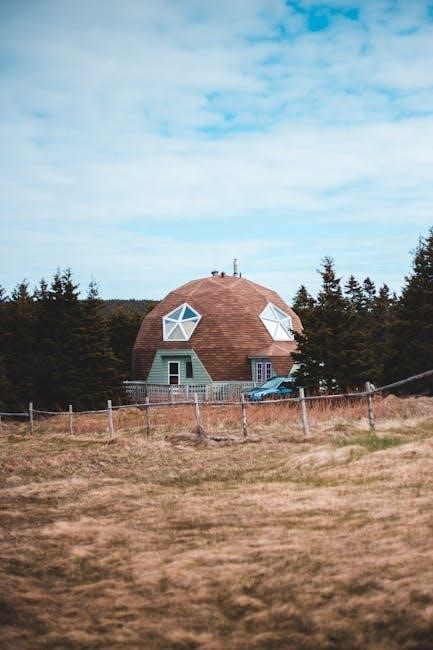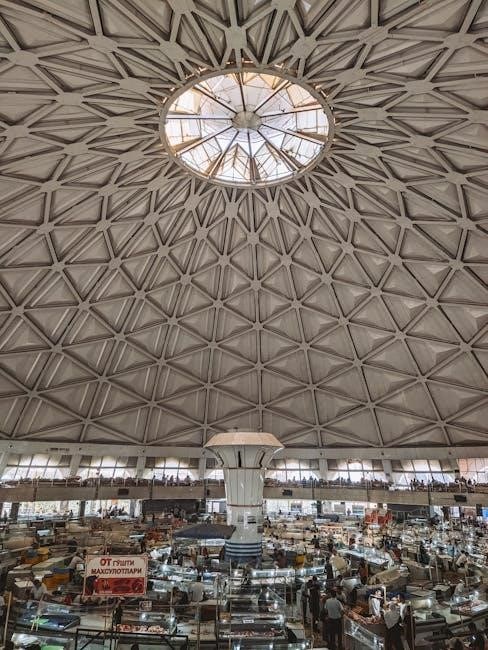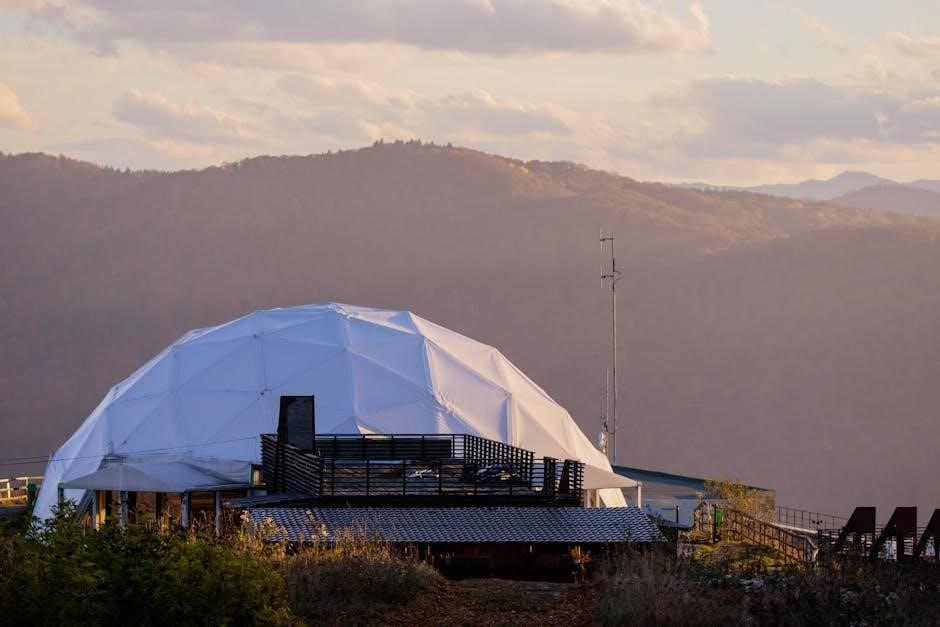Geodesic domes are popular for their durability and energy efficiency. Free PDF plans offer cost-effective solutions for constructing these structures. They provide detailed guides for building domes of various frequencies and sizes, using materials like PVC pipes or wood. These plans are ideal for DIY enthusiasts and sustainable living advocates, making geodesic dome construction accessible to everyone.
What are Geodesic Domes?
A geodesic dome is a spherical structure composed of interconnected triangles forming a lightweight, durable, and energy-efficient framework. Its design distributes stress evenly across the surface, making it highly resistant to external forces like wind and earthquakes. Geodesic domes are often used as greenhouses, shelters, or even homes due to their unique combination of strength and minimal material use. They can vary in size and frequency, with higher-frequency domes offering smoother curves and greater structural integrity. These domes are popular among DIY enthusiasts and sustainable living advocates, as they provide an eco-friendly and cost-effective alternative to traditional buildings. Their versatility allows them to be constructed from various materials, including metal, wood, or PVC pipes, making them accessible for both small and large-scale projects.
Why Use Free Geodesic Dome Plans?
Free geodesic dome plans offer a cost-effective and accessible way to embark on a dome-building project. These plans provide detailed instructions, material lists, and construction guides, making it easier for individuals to create their own domes without hiring professionals. They cater to a wide range of skill levels, from beginners to experienced builders, ensuring that everyone can participate. Using free PDF plans allows users to explore creative designs and customize their projects according to specific needs. Additionally, these plans often include tips for avoiding common mistakes and optimizing the construction process. By leveraging free resources, individuals can reduce costs and focus on sustainable, eco-friendly building practices. This accessibility makes geodesic domes a popular choice for DIY enthusiasts, educators, and those interested in innovative, energy-efficient structures.
Benefits of Geodesic Dome Structures
Geodesic domes are renowned for their exceptional strength, stability, and energy efficiency. Their spherical design distributes weight evenly, making them highly durable and resistant to external forces like wind and earthquakes. The structure’s aerodynamic shape minimizes material use while maximizing interior space, offering a cost-effective solution for various purposes, such as greenhouses, shelters, and event spaces. Energy efficiency is another key advantage, as the dome’s shape allows for optimal insulation and natural light distribution, reducing heating and cooling costs. Additionally, geodesic domes are eco-friendly and can be constructed using sustainable materials, making them a popular choice for environmentally conscious builders. Their unique aesthetic appeal also sets them apart from traditional structures, combining functionality with visual intrigue. Overall, geodesic domes provide a practical, efficient, and visually striking solution for a wide range of applications.

How to Find Free Geodesic Dome Plans Online
Discover free geodesic dome plans by exploring websites like Instructables, Domerama, and specialized forums. These platforms offer downloadable PDF guides for various dome designs and sizes.
Best Websites for Downloading Free PDF Plans
Several websites offer free geodesic dome plans in PDF format. Instructables and Geodesic Dome Hub provide detailed DIY guides and blueprints. Domerama offers over 2,500 downloadable plans, perfect for various projects. Additionally, forums like GeoDome and Reddit communities share user-created designs. These resources cater to different skill levels, ensuring everyone can find suitable plans for their geodesic dome projects.
How to Download and Use Geodesic Dome Plans
Downloading free geodesic dome plans is straightforward. Visit websites like Instructables or Domerama, browse their PDF collections, and select the desired plan. Once downloaded, review the materials list and instructions. Ensure all tools and materials are ready before starting construction. Follow the step-by-step guide carefully, adhering to measurements and assembly instructions. Some plans include calculators for precise strut lengths, enhancing accuracy. Print the plans for easy reference during the build process. Always verify the plan’s frequency and size match your project needs. By following these steps, you can successfully use the plans to construct a durable and efficient geodesic dome.
Verifying the Quality and Accuracy of Free Plans
Verifying the quality and accuracy of free geodesic dome plans is essential for a successful project. Start by checking the source of the plans, ensuring they come from reputable websites or communities. Look for reviews or feedback from users who have successfully built domes using the plans. Review the document for detailed instructions, clear diagrams, and a comprehensive materials list. Check that all measurements and calculations, such as strut lengths and frequencies, are provided and consistent. Use online calculators or software to verify the math behind the design. Cross-reference the plans with established geodesic dome construction guides or books to ensure accuracy. Be wary of plans with missing or vague instructions, as they may lead to errors. By carefully evaluating the plans, you can ensure they are reliable and suitable for your project.
Understanding Geodesic Dome Construction
Constructing a geodesic dome involves using materials like wood or PVC pipes, following precise plans to ensure structural integrity and durability, essential for sustainable and energy-efficient buildings.
Basic Materials and Tools Needed
Building a geodesic dome requires essential materials like PVC pipes, wood, or metal frames for the structure. Hubs or connectors are crucial for joining the struts. Tools include saws, drills, measuring tapes, and wrenches. A sturdy foundation is necessary for stability. Detailed plans guide the cutting and assembly process. Sustainable materials like recycled wood or lightweight metals are popular choices. Proper tools ensure precise measurements and secure connections. The materials’ durability and cost-effectiveness make geodesic domes a practical option for various purposes, from greenhouses to shelters. Using free PDF plans, you can optimize material usage and minimize waste, making the project eco-friendly and budget-friendly. Ensure all materials align with your dome’s intended use and environmental conditions for long-lasting results.
Step-by-Step Construction Process
Begin by preparing the site and foundation, ensuring it is level and secure. Cut the struts to the specified lengths using the measurements from your free PDF plans. Assemble the hubs or connectors, which will hold the struts together. Start constructing the dome’s base by attaching the struts to the hubs, following the pattern outlined in the plans. Gradually build upward, connecting each strut precisely to maintain the dome’s structural integrity. Use a ladder or scaffolding for higher sections, ensuring safety. Once the framework is complete, attach the exterior panels or coverings, such as PVC or fabric, to weatherproof the dome. Add doors, windows, and ventilation as needed. Finish with interior details like flooring or insulation. This method ensures a sturdy and functional geodesic dome, perfect for various uses like greenhouses or shelters.

Common Mistakes to Avoid
When using free geodesic dome plans, avoid improper strut length calculations, as this can compromise the dome’s structural integrity. Ensure all measurements match the specified frequency and size. Incorrect hub assembly is another common error, as misaligned connectors can lead to a weakened framework. Always follow the PDF plan’s instructions for assembling hubs and attaching struts. Using inadequate materials, such as thin PVC pipes or weak wood, can result in a dome that cannot withstand stress. Double-check the recommended materials and their thickness. Rushing the assembly process can lead to misaligned struts and poor framework stability. Work methodically, especially when building larger domes. Additionally, neglecting to secure the dome properly to the ground can cause instability. Use anchors or a sturdy foundation to prevent shifting. Lastly, avoid ignoring safety precautions, such as overreaching or failing to stabilize the structure during construction. Always use scaffolding or ladders safely.

Design Variations and Customization
Geodesic domes can be customized in various frequencies, sizes, and materials; Free PDF plans often include options for different applications, allowing users to tailor designs for greenhouses, shelters, or event spaces.
Different Frequencies and Sizes of Geodesic Domes
Geodesic domes come in various frequencies, such as 2v, 3v, and 4v, which determine the number of triangles and overall structure. Higher frequencies offer smoother curves but require more materials. Sizes range from small, portable shelters to large, industrial greenhouses. Free PDF plans often include templates for domes of different diameters, allowing users to choose based on their needs. For instance, a 2v dome is ideal for simple projects, while a 4v dome provides greater structural integrity for larger applications. Materials like PVC pipes or wood can be scaled to fit various sizes. These variations make geodesic domes versatile for purposes like camping, storage, or even event spaces. The plans typically include calculations for strut lengths and connector angles, ensuring accuracy regardless of size or frequency.

Customizing Your Geodesic Dome Design

Customizing your geodesic dome design allows you to tailor the structure to your specific needs and preferences. Free PDF plans often include options for adjusting materials, colors, and additional features. You can choose from various frequencies and sizes, as well as incorporate windows, doors, and skylights for natural light. Exterior finishes like paint, metal, or fabric can enhance durability and aesthetics. Interior customization might include shelving, flooring, or insulation for comfort. Some plans even offer advanced techniques for intricate designs, such as multi-frequency domes or hybrid structures. By modifying the basic template, you can create a unique space that reflects your lifestyle or purpose, whether it’s for a greenhouse, storage, or a cozy retreat. These customization options make geodesic domes versatile for both functional and creative applications.
Advanced Techniques for Complex Designs
Advanced techniques for complex geodesic dome designs involve intricate patterns and multi-frequency structures. These methods allow for more scalable and visually striking domes. Using software tools, enthusiasts can experiment with 3D modeling to create custom shapes. Multi-frequency domes combine different geometries, offering greater structural strength and aesthetic appeal. Hybrid designs blend geodesic principles with other architectural styles, such as incorporating traditional framing. For larger projects, advanced techniques include reinforced frameworks and modular construction. Detailed PDF plans often provide step-by-step guides for executing these complex designs. By mastering these techniques, builders can create unique, high-performance geodesic domes tailored to specific needs. These advanced methods are ideal for experienced builders aiming to push the boundaries of geodesic architecture, ensuring both functionality and visual impact. The use of precision tools and detailed plans makes even the most complex designs achievable.
Additional Resources and Tools
Geodesic dome calculators and software aid in precise strut calculations. Online forums offer valuable support, while books provide in-depth guides for complex designs and troubleshooting.
Geodesic Dome Calculators and Software
Geodesic dome calculators are essential tools for precise strut length calculations, ensuring accuracy in construction. Free software, like the 2V Geodesic Dome Calculator, simplifies the process by providing measurements in feet and inches. These tools are often complemented by downloadable PDF guides, offering step-by-step instructions for various frequencies and sizes. They cater to both DIY enthusiasts and professional builders, making complex designs more accessible. Additionally, some calculators support multiple shapes, such as octahedrons or tetrahedrons, expanding creative possibilities. With these resources, users can streamline their planning and construction processes, saving time and reducing errors. They are particularly useful for those exploring sustainable and energy-efficient building methods. By combining calculators with detailed PDF plans, individuals can achieve professional-grade results without significant costs.
Online Communities and Forums for Support
Online communities and forums provide invaluable support for geodesic dome enthusiasts. Platforms like Domerama and specialized DIY forums offer spaces to share experiences, ask questions, and gain insights from experts. These communities often include discussions on free PDF plans, construction tips, and troubleshooting common issues. Members frequently share their own projects, highlighting successes and lessons learned. Additionally, many forums provide access to downloadable resources, such as detailed diagrams and calculators, to aid in construction. These spaces foster collaboration and innovation, making them indispensable for both beginners and experienced builders. By engaging with these communities, individuals can refine their geodesic dome projects and explore creative customization ideas. The collective knowledge available online ensures that builders can overcome challenges and achieve their goals effectively.
- Share experiences and gain insights from experts.
- Access free resources like diagrams and calculators.
- Learn from others’ projects and avoid common mistakes.
Recommended Books and Guides
For those seeking in-depth knowledge on geodesic domes, several books and guides are highly recommended. “Homes, Domes, Barns, and Houseboats” by Lloyd Kahn is a popular resource, offering insights into unconventional structures, including geodesic domes. Another valuable guide is “The Geodesic Dome Manual”, which provides step-by-step instructions for construction. Additionally, “Building a Geodesic Dome Greenhouse” is a must-read for those interested in sustainable gardening. These books complement free PDF plans by offering detailed explanations and expert tips. Many of these guides are available in digital formats, making them easily accessible. They cover topics like materials selection, construction techniques, and customization options. Whether you’re a beginner or an experienced builder, these resources will enhance your understanding and help you achieve a successful project.
- “Homes, Domes, Barns, and Houseboats” by Lloyd Kahn
- “The Geodesic Dome Manual”
- “Building a Geodesic Dome Greenhouse”
